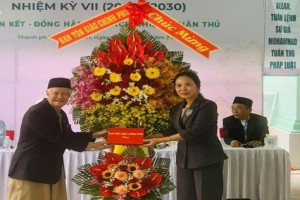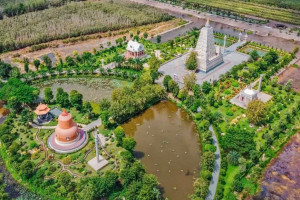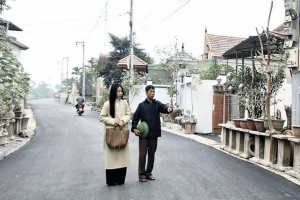Buddhism was brought to Vietnam about two thousand years ago. Luy Lâu (now in the Thuận Thành District, Bắc Ninh province in Northern Vietnam) soon became a large and flourishing center for Buddhism.
Buddhism first reached Vietnam from India by sea. Monks from India and Central Asia visited Vietnam along with traders. Those who engaged in missionary work include Mahajivaka and K’sudra at the end of the second century A.D., Khương Tăng Hội and Chi Lương Cương (Kalyana – Siva) in the middle of the third century A.D., and then Dharmadeva in the fourth century A.D..
From the fifth to the tenth century, due to historical circumstances, Chinese Buddhism began gradually to influence Buddhism in Vietnam. From the tenth to the fifteenth century, Vietnamese Buddhism moved into a new era of development that accompanied the country’s independence. Certain Buddhist monks were allowed to attend to court affairs under the rule of the Đinh – Lê Dynasties (from the late tenth to early eleventh century). Buddhism flourished during the Lý – Trần Dynasties (from the eleventh to the fourteen century), when many Buddhist monks helped the kings to protect the country. Soon, Buddhism came to be considered as the state religion. Pagodas were built and maintained; Buddhist doctrine, organizations, and practices enjoyed favorable conditions for development. Some kings even decided to lead a religious life. King Trần Nhân Tông was the founder of the Trúc Lâm Yên Tử (Trúc Lâm Congregation of Zen Buddhism at Yên Tử in Quảng Ninh province, Northern Vietnam). This denomination bears Vietnamese characteristics of creativity, tolerance, and secularity. After the fifteenth century, Buddhism gradually gave way to Confucianism. However, it still maintained its position among “Three religions from the same source”.
Theravada Buddhism entered Southern Vietnam during the fourth century A.D.. Theravada believers were mainly among the Khmer ethnic group in the Mekong Delta; the Congregation became known as Khmer Theravada Buddhism. Khmer Theravada Buddhism made many contributions to the defense and development of the nation. During the wars against foreign aggression, the Khmer Theravada Buddhist leaders and followers took part in the resistance movements to secure independence for the Homeland. In 1981, the Khmer Theravada Buddhists joined the Vietnam Buddhist Sangha during the Representative Congress for Uniting Buddhist Organizations and Denominations. The Khmer Theravada Buddhists now have 452 pagodas, more than one million believers, and almost 9,000 monks. In addition, there are about 500 Theravada Buddhist monks among Kinh people in a number of provinces in the Center and South East of the country.
During its entry and development in Vietnam, Buddhism prove to be a peaceful religion that could harmonize with native beliefs and closely ally itself with and accompany the nation during its defense and construction.
The beginning of the twentieth century was a time of major social, economic, and cultural change. Movements to revitalize Buddhism arose in several Asian countries, including China, Japan, and Vietnam. Beside its religious significance, the Movement to Revitalize Buddhism in Vietnam also had political and social implications and fit together with the national liberation struggle.
The Movement to Revitalize Buddhism first emerged in Sài Gòn in 1920 through pioneering monks, such as Khánh Hòa and Thiện Chiếu... It then spread to the Central and Northern regions through the participation of the Most Venerable Giác Tiên, Venerable Tố Liên, Venerable Trí Hải... and lay believers such as Lê Đình Thám, Nguyễn Năng Quốc, Phan Kế Bính, and Trần Văn Giáp...
During this period, a number of Buddhist organizations were founded in all three regions (North, Center, and South). Of these, six organizations were particularly significant. In the South: The Southern Buddhist Study Association (Hội Nam Kỳ Nghiên cứu Phật học) founded in 1930 and the Southern Vietnamese Buddhist Association (Hội Tăng già Nam Việt) founded in 1951. In the Center: The Annam Buddhist Study Association (An Nam Phật học Hội) founded in 1932 and the Central Vietnamese Buddhist Association (Hội Tăng già Trung Việt) founded in 1949. In the North: The Northern Buddhist Association (Hội Phật giáo Bắc Kỳ) founded in 1934 and the Buddhist Clergy Rectification Association of Northern Vietnam (Hội Chỉnh lý Tăng ni Bắc Việt) founded in 1949. In 1950, this association changed its name to the Northern Vietnamese Buddhist Association (Hội Tăng già Bắc Việt).
In 1951, those organizations gathered in Huế and agreed to establish the Vietnamese Confederation of Buddhist Associations (Tổng hội Phật giáo Việt Nam). This event can be considered as the first important drive for Buddhist unification organizationally in the history of Vietnamese Buddhism.
The Movement to Revitalize Buddhism lasted until 1954. The overwhelming majority of Buddhist clergy and followers maintained their traditional patriotism and joined the mainstream of the nation while following their religious practices in accordance with their ancestries. They actively contributed to the victory of the August 1945 Revolution as well as to the Resistance War against colonial aggression. Many monks, nuns, and followers joined the Việt Minh and the Inter-Việt Front. Many pagodas became resistance bases and sanctuaries for revolutionary cadres.
Particularly in Southern Vietnam, the Buddhist National Salvation Association (Phật giáo cứu quốc) attracted a large number of monks and nuns to take part in patriotic activities.
After 1954, the separation of the country into North Vietnam and South Vietnam brought about substantial changes in the situation of Buddhism:
In the North, in September 1957, prominent clergy campaigned to form a new Buddhist organization. In March 1958, the Conference of Northern Representative Clergy established the Vietnamese United Buddhist Association (Hội Phật giáo Thống nhất Việt Nam) with the aim of “creating harmony among nuns, monks, lay people, and researchers to: propagate Buddhism, benefit the population, serve the Homeland, and protect peace". After its founding, in addition to its religious practices, the Vietnamese United Buddhist Association actively participated in social and patriotic movements, contributed to national defense and construction of the Homeland in the North, and helped to liberate the South and unify the nation. The founding of the Buddhist Association and its positive activities served as an important step in the history of Northern Buddhism’s close association with the nation in the North.
In the South, the period from 1954 to 1975 witnessed the foundation of dozens of Buddhist organizations, including: The Original Buddhist Association (Tăng già Nguyên Thủy), the Mendicant Monks’ Congregation (Khất sĩ), the T’ien-t’ai School Association (Thiên Thai Giáo Quán tông), and the Vietnamese Buddhist Study Association (Hội Phật học Nam Việt). After the collapse of the Ngô Đình Diệm regime, the Vietnamese United Buddhist Sangha (Giáo hội Phật giáo Việt Nam Thống nhất) was founded in 1964 by uniting several Buddhist denominations and organizations in which the Vietnamese Confederation of Buddhist Associations (Tổng hội Phật giáo Việt Nam) played a central role. A short time after its founding, the Vietnamese United Buddhist Sangha (Giáo hội Phật giáo Việt Nam Thống nhất) began to split into factions; a small group exploited by foreigners for political purposes, broke off as separate entity. However, the majority of the clergy and followers remained loyal to the nation, were patriotic, and participated in the liberation of the South and in national unification.
After 1975, the Vietnamese United Buddhist Sangha continued its activities in Vietnam and continued to implement the Movement to Revitalize Buddhism during the time the country was reunited. The overwhelming majority of monks, nuns, and followers indicated their wish to unifying all Buddhist sects into one common organization, and indeed the chance came for that wish to be fulfilled. In February 1980, a Preparatory Committee for Buddhist Unification (Ban Vận động Thống nhất Phật giáo) was established with 33 members representing Buddhist denominations from across the nation. In November 1981, the Conference of Representatives for Buddhist Unification was organized in Hà Nội capital with the participation of 165 representative monks, nuns, and lay people from nine different denominations: The Vietnamese United Buddhist Sangha (Giáo hội Phật giáo Việt Nam Thống nhất), the Unified Vietnamese Buddhist Association (Hội Phật giáo Thống nhất Việt Nam), the Vietnamese Traditional Buddhist Sangha (Giáo hội Phật giáo Cổ truyền Việt Nam), the Hồ Chí Minh City Buddhist Liaison Committee (Ban Liên lạc Phật giáo Thành phố Hồ Chí Minh), the Vietnamese Original Buddhist Sangha (Giáo hội Tăng già Nguyên thủy Việt Nam), the Southwestern Patriotic Clergy Solidarity Association (Hội Đoàn kết Sư sãi Yêu nước Tây Nam Bộ), the Vietnamese Mendicant Monks Buddhist Sangha (Giáo hội Tăng già Khất sĩ Việt Nam), the T’ien-t’ai School Sangha (Giáo hội Thiên Thai giáo Quán tông), and the Vietnamese Buddhist Study Association (Hội Phật học Nam Việt).
The Conference unanimously agreed to establish the Vietnamese Buddhist Sangha (Giáo hội Phật giáo Việt Nam) and promoted a motto for action: “The Dharma – The Nation – Socialism". On 7 November 1981, the conference also elected the leadership of the Sangha. Most venerable Thích Trí Thủ, on behalf of the Conference Presidium, read the Appeal of the Congress for the Unification of Vietnamese Buddhists, at Quán Sứ pagoda, noting: “From this point on, we are no longer Buddhists of the South, Buddhists of the Center, or Buddhists of the North and are no longer split into diversing organizations or forms but are all Vietnamese Buddhists and are all members of the Vietnamese Buddhist Sangha, whether inside the country or outside the country".
After this historic landmark of Vietnamese Buddhism, monks, nuns, and followers from across the nation continued their patriotic tradition in line with “helping with the propagation of Buddhism, serving the Homeland, and bringing peace and contentment to the world". The Vietnamese Buddhist Sangha continued to develop through the contribution of clergy and followers nationwide and has earned a position of respect in the hearts and minds of the population. The Vietnamese Buddhist Sangha has organized five national congresses: The first in 1981, the second in 1987, the third in 1992, the fourth in 1997, and the fifth in 2002.
The Vietnamese Buddhist Sangha is currently organized into two levels: The top level is the Buddhist Sangha Patronage Council and the Dharma Executive Council at the central level, with 11 departments: Clergy Affairs; Clergy Education; Buddhist Guidance; Propagation; Rituals; Culture; Economics and Finance; Social Charity; Buddhist International Affairs; the Institute for Buddhism Study; and Administration.
Under the central level are the Provincial/City Executive Boards, District Representative Boards, and Village (Ward) Representatives. Grassroots units of the Vietnamese Buddhist Sangha are pagodas, temples, monasteries, and nunneries.
Vietnamese Buddhism has a history of nearly twenty centuries. Today, Buddhist clergy and followers nationwide under the leadership of the Vietnamese Buddhist Sangha contribute significantly to the country’s Reform and Renewal (Đổi mới).





